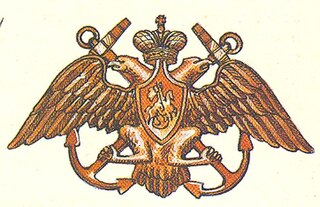
The Crimean War was fought from October 1853 to February 1856 between the Russian Empire and an ultimately victorious alliance of the Ottoman Empire, France, the United Kingdom, and Sardinia-Piedmont. Geopolitical causes of the war included the decline of the Ottoman Empire, the expansion of Russia in the preceding Russo-Turkish Wars, and the British and French preference to preserve the Ottoman Empire to maintain the balance of power in the Concert of Europe. The flashpoint was a disagreement over the rights of Christian minorities in Palestine, then part of the Ottoman Empire, with the French promoting the rights of Roman Catholics, and Russia promoting those of the Eastern Orthodox Church. However, this served only as a pretense for the war; in fact, the countries were fighting over who would rule the Ottoman Empire.

Moritz Hermann von Jacobi, also known as Boris Semyonovich Yakobi, was a German-Russian electrical engineer and physicist.

Pavel Stepanovich Nakhimov was a Russian admiral in the Imperial Russian Navy known for his victory in the Battle of Sinop and his leadership in the Siege of Sevastopol (1854–1855) during the Crimean War.

Kronstadt is a Russian port city in Kronshtadtsky District of the federal city of Saint Petersburg, located on Kotlin Island, 30 km (19 mi) west of Saint Petersburg, near the head of the Gulf of Finland. It is linked to the former Russian capital by a combination levee-causeway-seagate, the St Petersburg Dam, part of the city's flood defences, which also acts as road access to Kotlin island from the mainland.

The Imperial Russian Navy operated as the navy of the Russian Tsardom and later the Russian Empire from 1696 to 1917. Formally established in 1696, it lasted until being dissolved in the wake of the February Revolution and the declaration of the Russian Republic in 1917. It developed from a smaller force that had existed prior to Tsar Peter the Great's founding of the modern Russian navy during the Second Azov campaign in 1696, and expanded in the second half of the 18th century before reaching its peak strength by the early part of the 19th century, behind only the British and French fleets in terms of size.

Fort Alexander, also Fort Alexander I, or Plague Fort is a naval fortress on an artificial island in the Gulf of Finland near St. Petersburg and Kronstadt. From 1899 to 1917, the fort housed a research laboratory on plague and other bacterial diseases.

Grigory Ivanovich Butakov was a Russian admiral who fought in the Crimean War. Butakov is widely credited as being the father of steam-powered ship tactics during the 19th century. He was involved in the first battles of the Crimean War, which includes the first sea battles involving steam-powered ships. Butakov wrote of his experiences in his book: New Principles of Steamboat Tactics (1863), which won him the Demidov Prize. In 1881 Butakov assumed the role of Commander-in-Chief of the Port of St. Petersburg. He was also made a member of the State Council in March 1882. Shortly after gaining both titles however, Butakov fell seriously ill, and died on 31 May 1882, aged 62. The minor planet 4936 Butakov was named in his memory.

The Baltic Fleet, also known as the Baltic Squadron, were a series of formations of the British Royal Navy which existed between 1658 to 1856. They consisted of ships assembled at Spithead, a naval anchorage in the English Channel, for various naval operations in the Baltic Sea. The formations were under the ultimate command of the Commander-in-Chief, Baltic Fleet.
Rostislav was an 84-gun third-rate ship of the line built for the Black Sea Fleet of the Imperial Russian Navy in the 1840s as part of a naval expansion program to strengthen the fleet during a period of increased tension with Britain and France. Rostislav carried a battery primarily consisting of traditional shot-firing guns, but she also carried eight new shell-firing guns. The ship saw combat during the Crimean War at the Battle of Sinop in 1853, where the Russian shell guns proved to be decisive. She repaired in Sevastopol in 1854 and was scuttled during the Siege of Sevastopol in 1855.

Imperatritsa Maria was an 84-gun third rate ship of the line built for the Black Sea Fleet of the Imperial Russian Navy in the late 1840s and early 1850s as part of a naval expansion program to strengthen the fleet during a period of increased tension with Britain and France. The second and final member of the Khrabryi class, she was the last sail-powered ship of the line to be built for the Russian Navy.
Chesma was an 84-gun ship of the line built for the Black Sea Fleet of the Imperial Russian Navy in the 1840s. Chesma carried a battery primarily consisting of tradition shot-firing guns, but she also carried four new shell-firing guns. The ship saw combat during the Crimean War at the Battle of Sinop against an Ottoman squadron in 1853, where the Russian shell guns proved to be decisive. The battle prompted Britain and France to intervene to support the Ottomans, leading the Russian fleet to withdraw to Sevastopol to avoid a battle with an Anglo-French fleet. Chesma helped to defend Sevastopol, supporting Russian ground forces during a battle in February 1855 before being disarmed to strengthen the city's defenses and then scuttled to block the harbor entrance to the Anglo-French fleet in August.

Khrabryi was the lead ship of the Khrabryi class of ships of the line built for the Black Sea Fleet of the Imperial Russian Navy in the 1840s. She saw limited service during the Crimean War in 1853–1854; storm damage prevented her from participating in the Battle of Sinop, and the Russian fleet thereafter avoided battle with the British and French fleets that intervened on behalf of the Ottoman Empire. Disarmed during the Siege of Sevastopol, she was later scuttled there to block the harbor entrance in 1855.

The Khrabryi class was a pair of ships of the line built for the Black Sea Fleet of the Imperial Russian Navy in the 1840s and early 1850s. The class comprised two ships: Khrabryi and Imperatritsa Maria. The two ships were built as part of a naval expansion program aimed at strengthening the Black Sea Fleet during a period of increased tension with Britain and France over the continued decline of the Ottoman Empire. Both ships saw active service during the Crimean War, with Imperatritsa Maria serving as Pavel Nakhimov's flagship at the Battle of Sinop in November 1853, where the Russians annihilated an Ottoman squadron. The two ships were withdrawn to Sevastopol after the British and French intervention and were trapped there during the Siege of Sevastopol until 1855, when both were scuttled to block the harbor entrance.

Sviatoslav was a Sultan Makhmud-class ship of the line built for the Imperial Russian Navy's Black Sea Fleet in the 1840s. The ship participated in the Crimean War in 1853–1855, beginning with an operation to carry reinforcements for the Imperial Russian Army stationed in the Caucasus in October 1853. Storm damage prevented her from taking part in the Battle of Sinop the next month, but the British and French intervention in the war after that battle led ultimately to Sviatoslav's loss. The Russian fleet withdrew to Sevastopol to avoid battle with the Anglo-French fleet, and during the ensuing Siege of Sevastopol, she was converted into a hospital ship and eventually scuttled in February 1855.

Iagudiil was a Sultan Makhmud-class ship of the line built for the Imperial Russian Navy's Black Sea Fleet in the 1840s. Iagudiil had an uneventful career in the 1840s, alternating between periods in commission and in reserve. She participated in the early operations of the Black Sea Fleet during the Crimean War in October 1853, but her poor condition kept her from seeing action at the Battle of Sinop. The French and British intervention after Sinop led to the Russian retreat to Sevastopol, which was then besieged from 1854 to 1855. During the siege, Iagudiil battled French and British field artillery. After the Russian defenders were defeated in August 1855, they burned the ship to prevent it from being captured by the British and French, and the wreck was later demolished in 1857.

Varna was a Sultan Makhmud-class ship of the line built for the Imperial Russian Navy's Black Sea Fleet in the late 1830s and early 1840s. The ship had an uneventful career, apart from routine peacetime operations in the 1840s, interrupted by periods in reserve. In October 1853, she helped carry soldiers to the Caucasus to strengthen the Russian position there at the start of the Crimean War. In need of repairs, she was unable to take part in the Battle of Sinop in November, and thereafter remained in Sevastopol during the siege of the city. Her crew was sent ashore to reinforce the defenses and Varna was scuttled as a blockship in 1854 to bar the harbor entrance to French and British warships.

Uriil was a Sultan Makhmud-class ship of the line built for the Imperial Russian Navy's Black Sea Fleet in the late 1830s and early 1840s. The ship had a relatively uneventful career, operating with the Black Sea Fleet in the early 1840s before being laid up in 1845; apart from brief periods of activity in 1847 and 1849, she remained out of service until 1852. After the outbreak of the Crimean War in October 1853, she joined a squadron commanded by Pavel Nakhimov, but was unable to participate in the Battle of Sinop after a storm opened leaks in her hull. In poor condition, she was removed from service and her crew was sent to help man shore batteries during the Siege of Sevastopol. Uriil was then scuttled to block the harbor entrance in 1854.

Selafail was a Sultan Makhmud-class ship of the line built for the Imperial Russian Navy's Black Sea Fleet in the late 1830s and early 1840s. The ship had a relatively uneventful career, operating with the Black Sea Fleet in the early 1840s before being laid up in 1845; apart from brief periods of activity in 1847 and 1849, she remained out of service until 1852. After the outbreak of the Crimean War in October 1853, she was slated to join a squadron commanded by Pavel Nakhimov, but storm damage prevented her from taking part in the Battle of Sinop. The ship was eventually scuttled as a blockship in 1854 during the Siege of Sevastopol.

The Sultan Makhmud class was a group of eight 84-gun ships of the line built for the Black Sea Fleet of the Imperial Russian Navy. The class comprised Sultan Makhmud, Trekh Ierarkhov, Arkhangel Gavriil, Selafail, Uriil, Varna, Iagudiil, and Sviatoslav. They were built as part of a naval expansion program directed against the British and French, which Russia viewed as competitors to fill the power vacuum left by the continued decline of the Ottoman Empire. The ships represented an improvement over the traditional seventy-four, as improved building techniques allowed naval designers to build larger, more heavily armed vessels without sacrificing the hull strength that had made the seventy-fours such effective warships.










